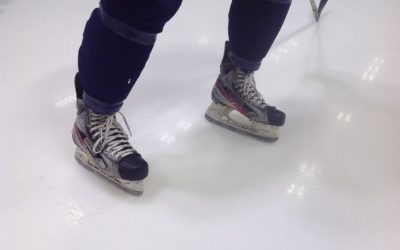Understanding reaction time?
Reaction time is a very important measure in sports, where speed of execution and decision-making are key determinants of performance. Although this concept is often associated with goalkeepers, players too need to be able to respond quickly to a given stimulus. Response time comprises three important components: the acquisition and transfer of information to the brain, the selection of a response, and movement time[1].
To better understand the concept, let’s take the example of a goalkeeper facing a shot from an opponent positioned in front of him:
Acquisition and transfer of information to the brain
To make the save, the goalkeeper must know where the player is going to throw. To do this, he uses his visual system (his eyes) to help him determine the puck’s trajectory and speed. Studies now show that the goalie not only looks at the puck after contact with the stick, but also uses other information prior to the shot, such as the position of the player’s hips[2]. The time it takes to retrieve this information is added to the time it takes to transfer it to the brain via the optic nerve.
Answer selection
In his brain, the goalkeeper compares the visual information sent by the eyes with what he already knows (past experience), then selects a motor response that corresponds to the trajectory he expects the puck to take. A response motor pattern is then programmed in the motor cortex and is ready to be launched to perform a movement.
Movement time
With the response selected and programmed, signals are sent to the muscles to create the desired action. Muscle activation and arm movement, for example, will be counted as movement time.
In short, reaction time (information acquisition and response selection) is a process that encompasses a series of events that take place in a very short time. It is added to the movement time to obtain the response time. Improving one of the three components will therefore reduce the overall response time.
Watch out! This concept is often confused with reflex. Although the term is frequently used, a reflex refers to an automatic response without processing by the brain. To say that a goalkeeper has good reflexes would therefore mean that he doesn’t need to process visual information.
Written by Léandre Gagné Lemieux, M.Sc. kinesiology
References
1.Schmidt RA, Lee TD (2005) Motor control and learning: A behavioral emphasis, 4th edition. Human Kinetics, Champaign, Illinois.
2.Williams AM, Davids K. (1998) Visual search strategy, selective attention, and expertise in soccer. Res Q Exerc Sport 69(2):111-28.
Want to stay on top of new articles before they’re published?
Subscribe to our newsletter.
From the same author
Why is it easier to turn left?
Why is it easier to turn left? MAXIME Sports physiotherapist In a field hockey match, various skating techniques are used to counter the opponent. A technique of choice for quickly changing direction while maintaining good speed is the sharp turn. On the one hand,...

